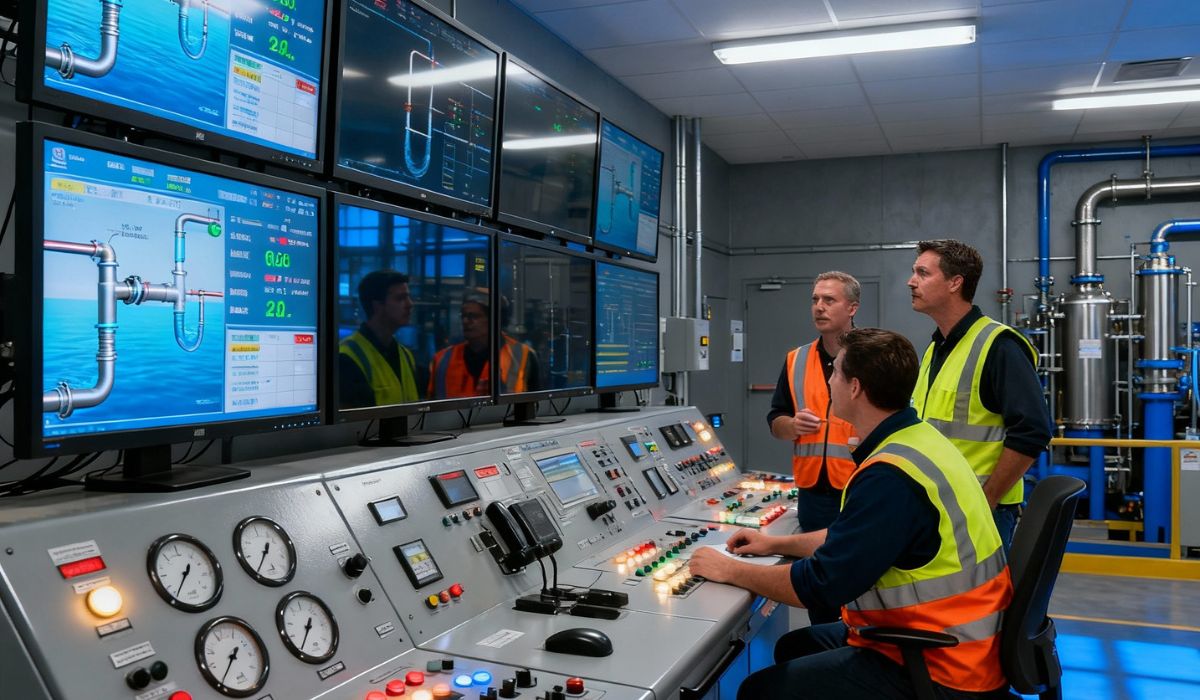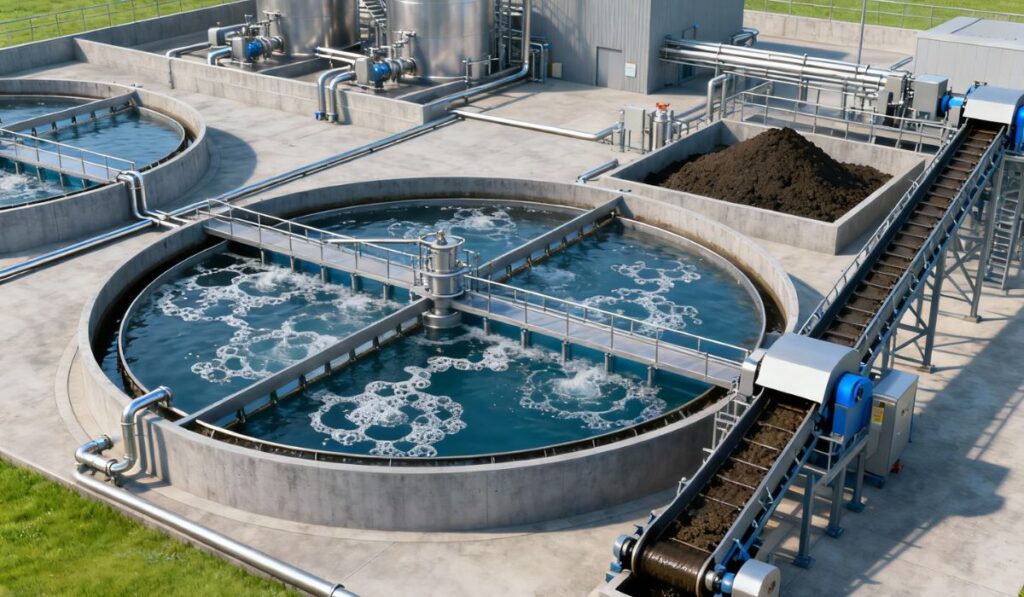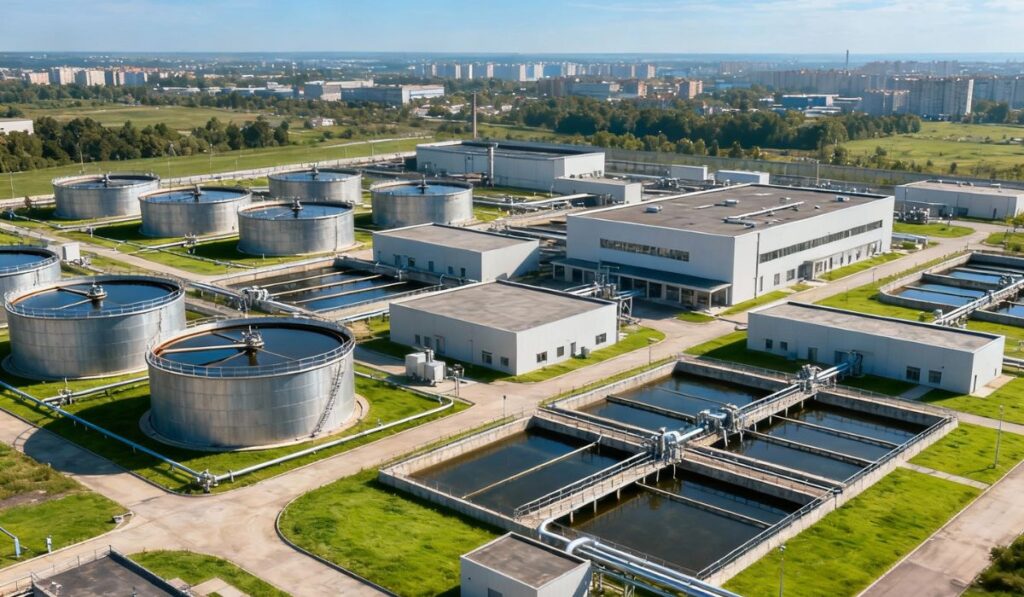-
Email us at:
info@weltreatsystems.com -
Call us on:
020 - 41228334 - Download Brochure

30
Sep 25The 5 Essential Steps of Wastewater Treatment (And Why They Matter)
- September 30, 2025
Introduction:

Every time you flush, shower, or wash dishes, you create wastewater. But where does it go? For facility managers and engineers, this isn’t a philosophical question—it’s a core operational responsibility. This water, laden with contaminants, undergoes an incredible transformation in a wastewater treatment plant. Understanding this process isn’t just academic; it’s critical for regulatory compliance, operational efficiency, and controlling costs. In this comprehensive guide, we’ll walk you through the five key stages of wastewater treatment and decode the essential chemistry behind it all.
The Wastewater Treatment Journey – An Overview
Before we dive into the details, here’s a quick visual guide to the path from dirty water to clean effluent.
(Start with a simple, branded infographic/diagram showing the 5 steps flowing from one to the next. This visual anchor is crucial.)
- Step 1: Preliminary Treatment -> Step 2: Primary Treatment -> Step 3: Secondary Treatment -> Step 4: Tertiary Treatment -> Step 5: Sludge Treatment
- Input: Raw Inflow | Output: Clean Effluent & Treated Biosolids
The 5 Key Stages of Wastewater & Sewage Treatment
Step 1: Preliminary Treatment – The First Line of Defense
This is the plant’s first line of defense, designed to remove the largest solids that could cause immediate damage or clogging.
- What it does: Removes large solid objects like sticks, rags, plastic, and other debris.
- How it works:
- Bar Screens: Wastewater passes through large screens that catch and remove bulky items.
- Grit Chambers: The flow then slows down in grit chambers, allowing heavy but fine materials like sand, gravel, and coffee grounds to settle out.
- Problem it solves: Prevents damage to pumps, clogging of pipes, and unnecessary wear on downstream equipment.
Weltreat Insight: “Protecting your investment starts at the beginning. Our heavy-duty screening systems are engineered for high flow rates and rugged conditions, ensuring your plant’s critical components are protected from the start, minimizing downtime and maintenance costs.”
Step 2: Primary Treatment – Separation by Settlement
With the large debris removed, the focus shifts to letting nature take its course—specifically, gravity.
- What it does: Removes suspended organic solid materials, often referred to as “raw sludge.”
- How it works: Wastewater flows into large, circular tanks called primary clarifiers. Here, the flow is slowed dramatically, allowing smaller organic particles to settle to the bottom as sludge, while oils and greases float to the surface to be skimmed off.
- Problem it solves: This physical separation process can remove 50-60% of suspended solids and 30-40% of the Biological Oxygen Demand (BOD), significantly reducing the load for the more intensive biological treatment stage.
Weltreat Insight: “Efficient settling is the bedrock of an effective plant. Our clarifier designs, including advanced scraper mechanisms and flow distribution systems, maximize solid removal, optimizing the entire treatment process and improving overall plant efficiency.”
Step 3: Secondary Treatment – The Biological Heart
This is where the real magic happens, using nature’s own cleaners—microorganisms—to tackle dissolved pollutants.
- What it does: Breaks down dissolved and suspended organic matter that survived primary treatment.
- How it works: The effluent is moved to aeration tanks where air is pumped in, and specific bacteria and microorganisms are introduced. These microbes consume the organic matter as food. Common systems include:
- Activated Sludge: A culture of microbes is mixed with wastewater and aerated.
- Moving Bed Biofilm Reactor (MBBR): Uses thousands of plastic carriers that provide a surface for bacteria to grow on, creating a highly active biofilm.
- Problem it solves: Tackles the invisible, dissolved pollutants that primary treatment can’t catch, significantly reducing BOD and COD levels.
Weltreat Insight: “This is where Weltreat truly excels. Our advanced MBBR and high-efficiency aeration solutions supercharge this biological process, delivering superior BOD/COD reduction results in a more compact and controllable footprint than conventional systems.”
Step 4: Tertiary (or Advanced) Treatment – The Polishing Phase
After biological treatment, the water is clean but may still contain fine solids, nutrients (like nitrogen and phosphorus), and pathogens. Tertiary treatment provides the final polish.
- What it does: Removes remaining nutrients, fine suspended solids, and disease-causing microorganisms.
- How it works:
- Filtration: Passing water through sand filters or advanced membrane filters to capture fine particles.
- Disinfection: Killing harmful pathogens using chlorine, ozone, or ultraviolet (UV) light.
- Nutrient Removal: Using specialized biological or chemical processes to strip out nitrogen and phosphorus.
- Problem it solves: Ensures the final effluent meets strict environmental discharge standards and is safe for reuse in applications like irrigation or industrial cooling.
Weltreat Insight: “Need to hit tough discharge limits or enable water reuse? Our tertiary systems, including chemical-free UV disinfection and advanced membrane filtration, provide the final polish for guaranteed compliance and enhanced sustainability.”
Step 5: Sludge Treatment – Dealing with the Byproduct
All the solids removed in the previous stages must be processed. This stage is crucial for managing waste and can even turn a problem into a resource.
- What it does: Processes the sludge collected from primary clarifiers and secondary treatment.
- How it works:
- Thickening: Concentrates the sludge to reduce volume.
- Anaerobic Digestion: Sludge is placed in sealed tanks without oxygen, where bacteria break it down, producing biogas (mostly methane) which can be used to generate electricity and heat for the plant.
- Dewatering: Using centrifuges or filter presses to remove as much water as possible, resulting a semi-solid cake that is much cheaper and easier to dispose of or use as agricultural fertilizer.
- Problem it solves: Drastically reduces the volume of waste for disposal, mitigates environmental impact, and can create a valuable energy source, lowering operational costs.
Weltreat Insight: “We view sludge not as waste, but as a resource. Our high-rate anaerobic digesters and robust dewatering technologies minimize disposal costs and can transform your plant’s waste stream into a valuable source of biogas, improving your bottom line.”
Beyond the Steps: Understanding COD and BOD in Wastewater
For engineers, two acronyms are fundamental to wastewater analysis: COD and BOD. Understanding the difference is key to designing and operating an effective treatment system.
COD vs BOD: What’s the Difference and Why Does It Matter?
- BOD (Biochemical Oxygen Demand): This measures the amount of oxygen required by bacteria to biologically break down the organic matter in water over a specific period (usually 5 days). It’s a direct measure of the “biological” pollution load.
- COD (Chemical Oxygen Demand): This measures the amount of oxygen required to chemically oxidize all the organic matter in the water. It’s a measure of the “total” oxidizable pollution, including both biodegradable and non-biodegradable organics.
The Key Takeaway: “COD is always higher than BOD. The COD/BOD ratio is a critical diagnostic tool. A high ratio suggests the presence of difficult-to-treat industrial chemicals, indicating that biological treatment alone may not be sufficient. This is the first thing we analyze when designing or troubleshooting a system for a client.”
Frequently Asked Questions (FAQs) About Wastewater Treatment
Your Top Wastewater Treatment Questions, Answered
Here are answers to some of the most common questions we receive from facility managers and engineers.
Q1. What is the difference between wastewater treatment and sewage treatment?
The terms are often used interchangeably. Technically, “sewage” refers to wastewater from domestic and commercial sources (toilets, sinks, showers). “Wastewater” is a broader term that includes sewage plus industrial effluent and any other used water from a community or industry. The treatment processes are very similar, though industrial wastewater may require pre-treatment for specific chemicals.
Q2. What are the biggest challenges in operating a wastewater treatment plant?
Common challenges include:
- Handling Variable Loads: Flow and contaminant concentration can change dramatically throughout the day.
- Meeting Stringent Discharge Limits: Especially for nutrients like nitrogen and phosphorus.
- High Energy Consumption: Aeration in secondary treatment is a major energy cost.
- Sludge Management: Disposing of treated sludge is often a significant operational and financial burden.
- Aging Infrastructure: Many plants face issues with outdated equipment and pipes.
Q3. How can I reduce the operational costs of my treatment plant?
Key strategies include:
- Optimizing Aeration: Using high-efficiency blowers and automated dissolved oxygen control can slash energy bills.
- Enhancing Sludge Treatment: Anaerobic digestion can turn sludge into biogas, offsetting energy costs.
- Preventive Maintenance: Preventing equipment failure is far cheaper than repairing it.
- Process Optimization: Regularly reviewing chemical dosing and biological health can reduce consumable costs.
Q4. What is MBBR technology and what are its advantages?
MBBR (Moving Bed Biofilm Reactor) is a compact and efficient secondary treatment technology. It uses thousands of small plastic carriers that move freely in the water, providing a large surface area for bacteria to grow on (a biofilm).
- Advantages: High treatment capacity in a small footprint, resilient to shock loads, no need for sludge recycling, and easy to retrofit into existing tanks.
Q5. Why is disinfection necessary, and which method is best: UV or Chlorine?
Disinfection is crucial to kill harmful pathogens (bacteria, viruses) before the water is discharged or reused.
- UV Disinfection: Uses ultraviolet light to damage the DNA of microbes. Pros: Chemical-free, immediate effect, safe to handle. Cons: Requires clean water (low turbidity) to be effective.
- Chlorine Disinfection: Uses chlorine gas or hypochlorite. Pros: Effective and provides a residual disinfectant that protects water in pipes. Cons: Produces potentially harmful disinfection by-products (DBPs), requires careful handling and storage.
The “best” method depends on your specific effluent quality, regulations, and safety requirements.
Q6. What should I do if my plant’s BOD/COD levels are too high?
High BOD/COD indicates an overloaded biological system. Steps to address this include:
- Source Identification: Check for slugs of industrial waste or other high-strength influent.
- Optimize Aeration: Ensure your aerators are providing enough oxygen for the bacteria.
- Bioaugmentation: Adding specialized bacterial strains to boost degradation.
- Evaluate Pre-Treatment: For high COD/BOD ratios, consider advanced oxidation processes (AOPs) or chemical coagulation as a pre-treatment step.
Conclusion & Next Steps
From Knowledge to Solution

Understanding these five steps, the underlying science of COD/BOD, and the solutions to common challenges is the foundation of effective wastewater management. But knowledge is only power when it’s applied. Every industrial facility has a unique wastewater profile, and a one-size-fits-all approach rarely works.
Is your system struggling with any of these stages? Are you facing challenges with high BOD/COD levels, sludge disposal, high energy costs, or meeting new regulations?
Let Weltreat Systems be your partner. We don’t just sell equipment; we deliver customized, end-to-end wastewater treatment solutions that are efficient, reliable, and built to last.
